Please use this identifier to cite or link to this item:
https://ahro.austin.org.au/austinjspui/handle/1/13549| Title: | Relative contributions of advanced glycation and nitric oxide synthase inhibition to aminoguanidine-mediated renoprotection in diabetic rats | Austin Authors: | Soulis, T;Cooper, Mark E;Sastra, S;Thallas, Vicki;Panagiotopoulos, Sianna ;Bjerrum, O J;Jerums, George | Affiliation: | Department of Medicine, University of Melbourne, Austin and Repatriation Medical Centre (Repatriation Campus), West Heidelberg, Australia | Issue Date: | 1-Oct-1997 | Publication information: | Diabetologia; 40(10): 1141-51 | Abstract: | Advanced glycation end products (AGEs) have previously been shown to be increased in the diabetic kidney. Aminoguanidine, an inhibitor of advanced glycation, has been shown to attenuate the development of AGEs as well as the progression of renal disease in experimental diabetes. However, the precise mechanisms through which aminoguanidine acts remain to be elucidated since it is also able to act as an inhibitor of nitric oxide synthase (NOS). This study has therefore compared the effects of aminoguanidine with the effects of two other inhibitors of NOS, L-NAME and methylguanidine, on the development of experimental diabetic nephropathy. Diabetic rats were randomised to receive no treatment, aminoguanidine (1 g/l in drinking water), L-NAME (5 mg/l in drinking water) or methylguanidine (1 g/l in drinking water). Diabetic rats had increased levels of albuminuria and urinary nitrite/nitrate excretion when compared to control rats. Renal AGEs measured by fluorescence as well as by a carboxymethyllysine reactive radioimmunoassay, were elevated in diabetic rats. No changes in inducible NOS (iNOS) protein expression were detected in experimental diabetes nor did aminoguanidine affect iNOS expression. Aminoguanidine did not affect blood glucose or HbA1c but it did prevent increases in albuminuria, urinary nitrites/nitrates and renal AGE levels as measured by fluorescence and radioimmunoassay. L-NAME and methylguanidine did not retard the development of albuminuria, nor did they prevent increases in renal AGE levels, as assessed by fluorescence. However, these treatments did prevent increases in AGEs, as measured by radioimmunoassay. This study indicates that the renoprotective effect of aminoguanidine in experimental diabetes cannot be reproduced by L-NAME or methylguanidine. It is likely that the effect of aminoguanidine is mediated predominantly by decreased AGE formation rather than via NOS inhibition. It also raises the possibility that inhibition of fluorescent AGE formation may be more renoprotective than inhibition of the formation of carboxymethyllysine-containing AGEs. | Gov't Doc #: | 9349594 | URI: | https://ahro.austin.org.au/austinjspui/handle/1/13549 | DOI: | 10.1007/s001250050799 | ORCID: | 0000-0002-0845-0001 | Journal: | Diabetologia | URL: | https://pubmed.ncbi.nlm.nih.gov/9349594 | Type: | Journal Article | Subjects: | Administration, Oral Albuminuria.metabolism.urine Animals Cohort Studies Diabetes Mellitus, Experimental.immunology.pathology.urine Enzyme Inhibitors.administration & dosage.pharmacology Glycosylation End Products, Advanced.immunology.metabolism.urine Guanidines.administration & dosage.pharmacology Immunohistochemistry Kidney Glomerulus.drug effects.immunology.metabolism.pathology Male Methylguanidine.administration & dosage.pharmacology NG-Nitroarginine Methyl Ester.administration & dosage.pharmacology Nitrates.urine Nitric Oxide Synthase.antagonists & inhibitors Nitrites.urine Random Allocation Rats Rats, Sprague-Dawley Time Factors |
| Appears in Collections: | Journal articles |
Files in This Item:
| File | Description | Size | Format | |
|---|---|---|---|---|
| 9349594.pdf | 2.74 MB | Adobe PDF |  View/Open |
Page view(s)
48
checked on Feb 5, 2025
Download(s)
138
checked on Feb 5, 2025
Google ScholarTM
Check
Items in AHRO are protected by copyright, with all rights reserved, unless otherwise indicated.
